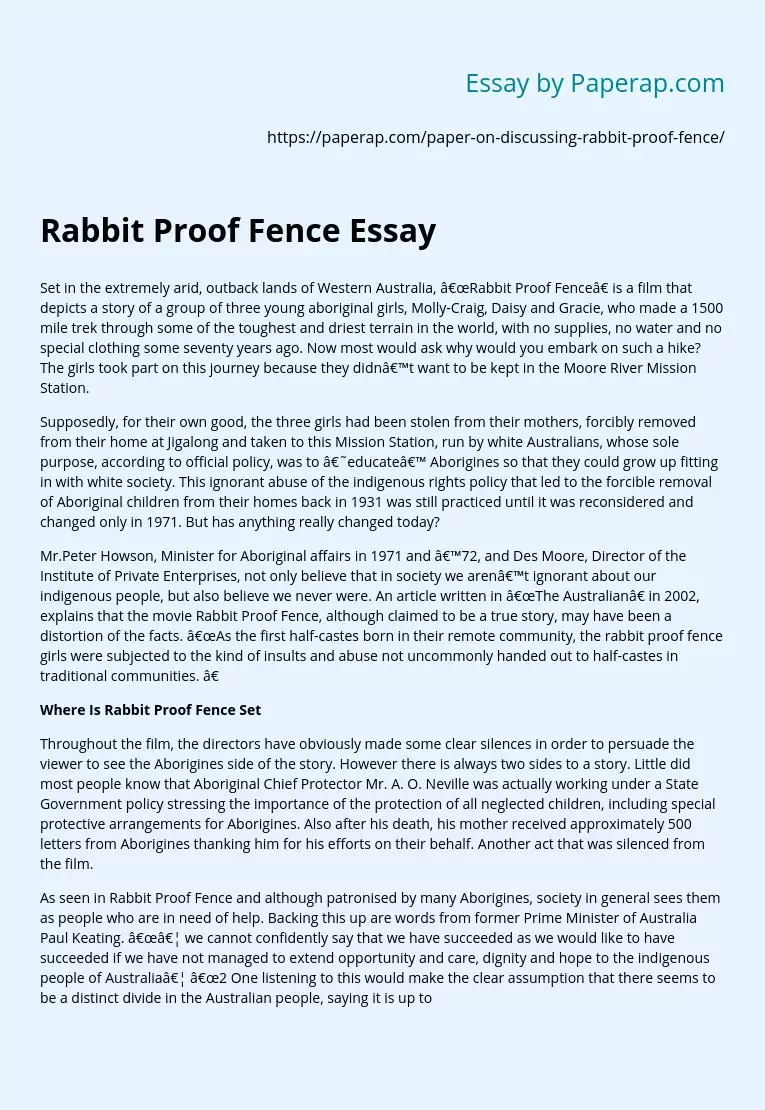Rabbit Proof Fence Essay
Set in the extremely arid, outback lands of Western Australia, “Rabbit Proof Fence” is a film that depicts a story of a group of three young aboriginal girls, Molly-Craig, Daisy and Gracie, who made a 1500 mile trek through some of the toughest and driest terrain in the world, with no supplies, no water and no special clothing some seventy years ago. Now most would ask why would you embark on such a hike? The girls took part on this journey because they didn’t want to be kept in the Moore River Mission Station.
Supposedly, for their own good, the three girls had been stolen from their mothers, forcibly removed from their home at Jigalong and taken to this Mission Station, run by white Australians, whose sole purpose, according to official policy, was to ‘educate’ Aborigines so that they could grow up fitting in with white society. This ignorant abuse of the indigenous rights policy that led to the forcible removal of Aboriginal children from their homes back in 1931 was still practiced until it was reconsidered and changed only in 1971.
But has anything really changed today?
Mr.Peter Howson, Minister for Aboriginal affairs in 1971 and ’72, and Des Moore, Director of the Institute of Private Enterprises, not only believe that in society we aren’t ignorant about our indigenous people, but also believe we never were. An article written in “The Australian” in 2002, explains that the movie Rabbit Proof Fence, although claimed to be a true story, may have been a distortion of the facts.
“As the first half-castes born in their remote community, the rabbit proof fence girls were subjected to the kind of insults and abuse not uncommonly handed out to half-castes in traditional communities. ”
Where Is Rabbit Proof Fence Set
Throughout the film, the directors have obviously made some clear silences in order to persuade the viewer to see the Aborigines side of the story. However there is always two sides to a story. Little did most people know that Aboriginal Chief Protector Mr. A. O. Neville was actually working under a State Government policy stressing the importance of the protection of all neglected children, including special protective arrangements for Aborigines. Also after his death, his mother received approximately 500 letters from Aborigines thanking him for his efforts on their behalf. Another act that was silenced from the film.
As seen in Rabbit Proof Fence and although patronised by many Aborigines, society in general sees them as people who are in need of help. Backing this up are words from former Prime Minister of Australia Paul Keating. “… we cannot confidently say that we have succeeded as we would like to have succeeded if we have not managed to extend opportunity and care, dignity and hope to the indigenous people of Australia… “2 One listening to this would make the clear assumption that there seems to be a distinct divide in the Australian people, saying it is up to us (white Australia) to help the indigenous population.
Rabbit Proof Fence is a film that silences many things, particularly the white-Australian logic behind the in-place policy to make the ‘villain’ the leader of the whites, Mr. Neville. Meanwhile the aborigines in the film, are portrayed as the victims who are trying to escape. An acclaimed Aboriginal Rights Activist Noel Pearson, mentioned something that truly backs up the film’s view. Pearson said that Aborigines who want equal rights and opportunities also need to develop a stronger sense of responsibility and that aboriginal leaders should, “stop depicting their people as victims. “3
Pearson also states that welfare, or “money for nothing”, often has more detrimental effects on Aboriginal communities, than it has benefits. The local pub in the Curtain Spring’s community in Alice Springs has imposed an alcohol ban for aborigines and this has caused a lot of commotion. Upon first sight of the pub, many visitors see this as an outright sign of discrimination. However, it was the 300 Aboriginal women of the area who in 1990 marched into the pub demanding the ban be set in place. 4 After seeing this, the white visitors feel it is their need to take it on personally and some supply alcohol to the local Aborigines.
The social representation of Aborigines as victims makes it very hard for people to understand the reasoning behind this alcohol ban. Unfortunately when this occurs, as a result heavy drinking and acts of violence take place. One could perhaps conclude that when white people interfere and try to ‘help’ indigenous communities, they only cause more problems. In many interviews and public addresses, the Prime Minister John Howard, has been put under pressure to deliver an official apology to Aborigines for the stolen generation problem.
This is an example of the lack of apology and want of reconciliation by white Australia and particularly the Government that provokes this problem of society’s representation and victimisation of Aboriginals. Should he apologise on behalf of the Australian Government, the problem faced by the Prime Minister is the legal litigation that he could incur. His stance on the subject is simple however, and somewhat different to that of his predecessor. – “We are one Australia”5 Although regarded as a somewhat ‘way out’ of apologising by the press, we must see this debate as Noel Pearson sees it.
Rabbit Proof Fence Essay. (2019, Dec 05). Retrieved from https://paperap.com/paper-on-discussing-rabbit-proof-fence/

